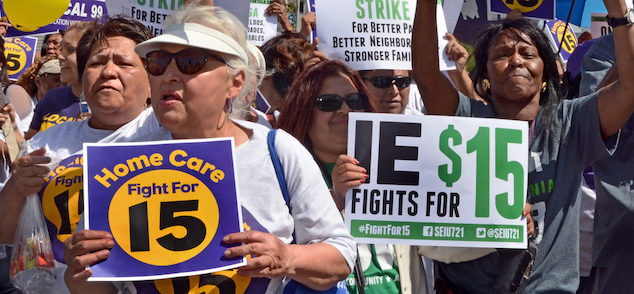News
California’s minimum wage rises to $15 per hour
 Supporters of the $15 minimum wage at a 2015 rally in Los Angeles. (Photo: Dan Holm, via Shutterstock)
Supporters of the $15 minimum wage at a 2015 rally in Los Angeles. (Photo: Dan Holm, via Shutterstock)Minimum-wage workers in the Golden State will get an hourly pay raise in the new year. Under California law, the state minimum wage rises to $15 per hour for employers with 26 or more workers and to $14 hourly for employers with 25 or less employees on Jan. 1, 2022.
California’s minimum wage is about double that set by the federal government.
This news began at the state Capitol. In April 2016, Democratic Gov. Jerry Brown, Jr. signed the measure into law. With the stroke of his pen, California became the first state in the U.S. to hike the hourly minimum wage. Labor unions and the “Fight for 15” campaign helped to push the then-governor to sign this bill.
“If restaurant owners want to thrive, they need to start by investing in their employees.” — Karter Louis
The law comes with metrics. “This law increases the minimum wage over time consistent with economic expansion, while providing safety valves to pause wage increases if negative economic or budgetary conditions emerge,” according to a Dec. 14 news release from the state Department of Industrial Relations.
There is business support for a higher minimum wage. Karter Louis is CEO of Soul Slice Pizza in Oakland. “For too long, the restaurant industry has put employees last,” he said in an email, “a low-wage model that has proven short-sighted and unsustainable.”
In 2017, California occupations with high rates of low-wage work ranged from “service jobs (such as food preparation workers, home care workers, and janitors), as well as jobs in the goods-producing sector (such as farm workers and warehouse workers),” according to the UC Berkeley Labor Center.
Louis, who is a member of Business for a Fair Minimum Wage, continues. “If restaurant owners want to thrive, they need to start by investing in their employees. At Soul Slice, we know that happy employees make for happy customers. Raising the minimum wage is good economic policy and good business.”
Sales can rise when, for instance, minimum-wage employees buy more goods and services.
Speaking of business policy, Denise Davis is the vice president of the California Chamber of Commerce, a leading advocacy group for employers that in part informs them on state laws. “CalChamber’s role has been to make sure our members are aware of the change and are providing the updated posting required with the change,” she said in an email.
Employers who fail to follow the state minimum wage law face penalties. “Workers paid less than the minimum wage are urged to contact the Labor Commissioner’s Office to file a wage claim,” according to the state DIR news release.
Backers of hiking the minimum wage cite workers’ expanded buying power. In this way, business sales can rise when, for instance, minimum-wage employees buy more goods and services. This is a theory of demand-side economics, whereby higher hourly pay yields increased consumer spending.
Minimum-wage proponents also hold that increasing the minimum wage makes it easier for employers to keep workers.
Promoters of increasing the minimum wage also say that it boosts productivity, or output per employee per hour. Workers that are more productive generate increased goods and services for their employers to sell. That in turn helps business owners cover their expenses.
Minimum-wage proponents also hold that increasing the minimum wage makes it easier for employers to keep workers. Thus, minimum-wage increases can spur employees to stay with employers versus leaving for another who offers higher hourly pay, or quitting altogether.
Improved employee retention, in turn, cuts employers’ costs of advertising for and training new hires. That process is an issue for firms operating on razor-thin profit margins in the pandemic age, as uncertainty rules the economic roost in big and small ways.
“We discuss the minimum wage, “but we leave a living wage out of the conversation.” — Amy Glasmeier, Allison Omen
The minimum wage in California is, however, not the same thing as a livable wage, or the approximate income families need for paying their bills. The latter is a more useful approach to measure the income an individual or family for paying their bills, according to Amy Glasmeier. She is a professor of economic geography and regional planning who helms the Lab on Regional Innovation and Spatial Analysis, in the Department of Urban Studies and Planning, at the Massachusetts Institute of Technology.
“We discuss the minimum wage,” write Prof. Glasmeier and Allison Omen, Chief Strategy Officer at JUST Capital, in a September Fortune article, “but we leave a living wage out of the conversation. Neither the current (federal, Ed.) minimum wage, at just $7.25 an hour, nor the proposed $15 an hour reflects what people need to get by.”
A case in point is the lack of affordable housing in areas like the Central Valley that is affecting minimum-wage workers, according to Prof. Glasmeier.
Minimum-wage hikes in 21 states begin on Jan. 1. Four more states increase their minimum wage later in 2022.
—
Editor’s Note: Seth Sandronsky reports regularly for Capitol Weekly. Contact him at
[email protected].
Want to see more stories like this? Sign up for The Roundup, the free daily newsletter about California politics from the editors of Capitol Weekly. Stay up to date on the news you need to know.
Sign up below, then look for a confirmation email in your inbox.

Leave a Reply